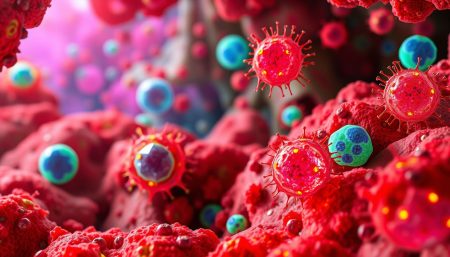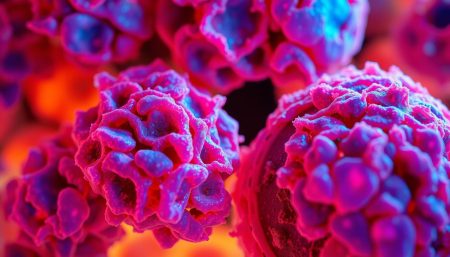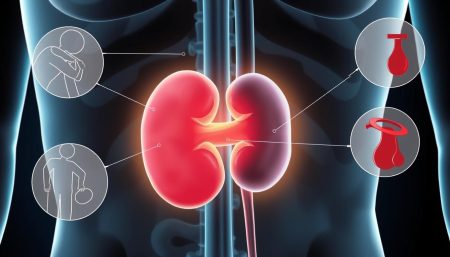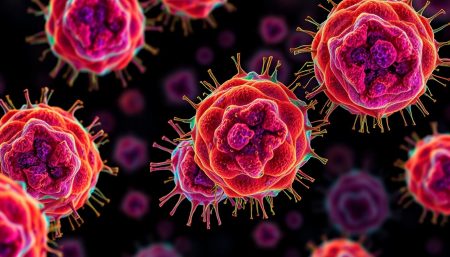The fight against cancer is changing with CAR T-cell treatment. This is a new way to fight cancer, using the body’s immune system. It’s a big step forward in cancer care, offering hope to patients and doctors.
This treatment is different from old ways of fighting cancer. It uses the body’s immune system to find and kill cancer cells. It’s a personalized approach, making it a powerful tool against cancer.
CAR T-cell therapy is more than just a treatment. It’s changing how we think about healthcare. It shows the power of innovation in medicine. It’s a step towards finding a cure for cancer.
Exploring CAR T-cell therapy shows its potential. It’s a bridge from dreams to reality, helping patients get better and live better lives.
Key Takeaways
- Introduction to the transforming landscape of cancer treatment via CAR T-cell therapy.
- Overview of how personalized immunotherapy represents a leap forward in cancer care.
- Insight into the unique aspects of CAR T-cell treatment as an innovative cancer therapy.
- Recognition of the potential impact on patient outcomes and the future of cancer therapy.
- Understanding CAR T-cell therapy’s role in enabling more precise, patient-centric treatment strategies.
Understanding CAR T-Cell Treatment
Chimeric Antigen Receptor (CAR) T-cell therapy is a big step forward in fighting cancer. It uses the body’s immune system to find and kill cancer cells. This method has opened new doors in treating cancer, giving hope to those with hard-to-treat diseases.
What is CAR T-Cell Therapy?
CAR T-cell therapy changes a patient’s T-cells to target cancer cells. It makes the body’s immune system better at killing cancer. This shows how adoptive cell transfer can be a key part of cancer treatment.
The Science Behind Chimeric Antigen Receptors
The heart of CAR T-cell therapy is the chimeric antigen receptor. These receptors are made to find specific proteins on cancer cells. This helps avoid harming healthy cells, a big problem in old treatments.
From Lab Research to Real-World Application
The move from lab to clinic shows big progress in cancer treatment. Early tests have turned into real treatments, helping patients who tried everything else. This success shows CAR T-cell therapy’s power and the future of cancer care.
The Evolution of Cancer Immunotherapy
The way we treat cancer has changed a lot with immunotherapy. It uses the body’s immune system to fight cancer. This is a new way that is less harsh than old treatments like chemotherapy or radiation.
Immunotherapy: A Game-Changer in Cancer Care
Immunotherapy is a big step forward in fighting cancer. It helps the body’s defenses to fight cancer cells better. CAR T-cell therapy is a key part of this, offering a treatment that fits each person’s cancer.
How CAR T-Cell Treatment Differs from Traditional Therapies
Unlike old treatments, CAR T-cell therapy only attacks cancer cells. This means fewer side effects and faster recovery. It’s a big part of targeted therapy in personalized medicine.
This shift to personalized and targeted treatments is a big deal in cancer care. It offers better results and hope for those fighting cancer. As research grows, CAR T-cell therapy’s potential keeps getting bigger. It shows a future where cancer treatment is better for patients’ health.
Eligibility for CAR T-Cell Treatment
To make CAR T-cell therapy safe and effective, picking the right patients is key. This careful selection is a big part of personalized medicine. It makes sure treatments fit each patient’s cancer and health perfectly. Let’s look at how doctors check if someone is a good fit for this treatment.
Assessing Patient Suitability
First, doctors look closely at a patient’s health history and current condition. They check many things to see if the treatment is right for them.
The Criteria for Treatment Selection
Choosing the right patients for CAR T-cell therapy has strict rules. These rules help make sure the treatment works well and is safe.
| Cancer Type | Stage of Cancer | Patient’s Overall Health | Prior Treatments |
|---|---|---|---|
| Lymphomas, Leukemia | Advanced or refractory | Must be relatively stable | Should have undergone standard therapies |
| Multiple Myeloma | Refractory | Good performance status | Prior chemotherapy and possibly stem cell transplant |
This table shows what’s needed for CAR T-cell therapy. Personalized medicine makes sure treatments are safe and work well for each patient.
The CAR T-Cell Treatment Procedure
CAR T-cell therapy is changing cancer treatment and the recovery journey. It shows how cellular immunotherapy is reshaping the field. This section explains the steps from cell collection to infusion of gene-modified cells.
Collection and Engineering of T-Cells
The first step is taking T-cells from a patient’s blood. These cells go to a lab for genetic modification. Scientists add synthetic receptors to the T-cells to target cancer cells.
This makes the T-cells into specialized cells. They can now find and kill cancer cells.
Infusion and the Patient’s Journey
After modification, the T-cells are multiplied in the lab. The patient then gets these cells back through infusion. This is when the body starts attacking cancer cells.
It’s important to watch for side effects and make sure the treatment works.
Getting this treatment is more than fighting cancer. It’s about going through a complex process. This process uses the latest in gene modification and immune system improvement.
| Stage of Treatment | Process | Duration |
|---|---|---|
| Collection of T-cells | Extraction from patient’s blood and transport to lab | 1-2 days |
| Engineering of T-cells | Genetic modification to add synthetic receptors | 2-3 weeks |
| Expansion of T-cells | Laboratory cultivation of modified cells | Variable, typically 1 week |
| Infusion | Reintroduction into patient’s bloodstream | 1 day |
| Monitoring and Support | Post-treatment care | Ongoing |
CAR T-cell treatment is a new hope for cancer patients. It shows a big step forward in medical science and patient care.
Targeted Therapy: A Focus on Gene-Modified Cells
The field of cancer treatment is growing fast. Targeted therapy and precision medicine are key, especially with gene-modified cells. This part talks about how genetic engineering boosts the power and accuracy of CAR T-cell treatments.
The Role of Genetic Engineering in CAR T-Cell Treatment
Genetic engineering is key in making CAR T-cell therapies. It changes T-cells’ genes so they can spot and attack cancer cells better. This precision medicine is a game-changer, helping to target cancer cells more effectively.
Targeting Cancer Cells with Precision
CAR T-cell treatment is known for its precise targeting of cancer cells. It uses special receptors designed to find specific proteins on cancer cells. This targeted therapy approach helps T-cells focus on cancer cells only, reducing harm to healthy cells and speeding up recovery.
For more insights, check out precision medicine strategies from experts.
| Targeted Gene | Function in CAR T-Cells | Impact on Cancer Cells |
|---|---|---|
| CD19 | Directs T-cells to B-cell lymphomas | High efficacy in targeting specific lymphoma cells |
| BCMA | Guides T-cells to multiple myeloma cells | Improves patient outcomes with targeted action |
| EGFR | Attacks cells expressing Epidermal Growth Factor Receptor | Useful in treating certain types of lung and colorectal cancers |
The leap in genetic engineering has boosted precision medicine. It’s making cancer care more tailored and effective.
Success Stories and Patient Outcomes
CAR T-cell therapy has changed cancer treatment in big ways. It’s not just a theory; it’s real for patients. Their stories show how this therapy has improved their lives.

Remission Cases with CAR T-Cell Therapy
Cancer treatment is tough and uncertain. But CAR T-cell therapy offers hope. Patients who got better share their stories of a new life.
These stories are about more than just not having cancer. They’re about living again. Patients can go back to work, celebrate birthdays, and enjoy family time. Each story shows how cancer treatment has gotten better.
Long-Term Effects and Quality of Life
Getting better from cancer is just the start. CAR T-cell therapy also makes life better in the long run. It helps patients live longer and enjoy their lives more.
Researchers are working hard to make these treatments even better. They want to reduce side effects and make patients feel even better. Here’s a table showing how patients’ lives improved after CAR T-cell therapy.
| Aspect of Life | Before Therapy | After Therapy |
|---|---|---|
| Physical Health | Poor | Improved |
| Emotional Wellbeing | Low | High |
| Social Activity | Limited | Regular |
| Overall Satisfaction | Unsatisfactory | Satisfactory |
The table shows a big improvement in patients’ lives after treatment. They feel better in many ways. This shows how CAR T-cell therapy can make life better for cancer survivors.
Ensuring Safety in CAR T-Cell Treatment
CAR T-cell therapies have changed the game for some cancers, giving hope to many. But, it’s crucial to focus on safety and manage side effects well. We must also keep a close eye on patient monitoring always.
Managing Potential Side Effects
Even though CAR T-cell therapy is groundbreaking, it comes with risks like cytokine release syndrome (CRS) and neurotoxicity. Spotting and handling these side effects early is key to better patient results. We use special medicines and plans to keep patients safe during and after treatment.
Monitoring Patient Progress Post-Treatment
Watching patients closely after treatment is crucial. It helps us see how they’re doing right away and catch any problems early. We check with lab tests, doctor visits, and how patients feel themselves. This careful watching helps us act fast if something goes wrong, keeping patients safe.
For more on CAR T-cell treatment and safety, check out this study. It talks about the rules and safety steps for these treatments.
| Aspect | Importance | Management Strategy |
|---|---|---|
| Cytokine Release Syndrome (CRS) | High | Preemptive use of cytokine inhibitors |
| Neurotoxicity | High | Immediate neurological assessments |
| Long-term follow-up | Essential | Regular clinic visits and patient education |
Financial Considerations of CAR T-Cell Therapy
When thinking about CAR T-cell therapy, it’s key to understand the financial considerations. This treatment is expensive and can affect a patient’s choices. We’ll look at the costs, insurance options, and help for financial aid.
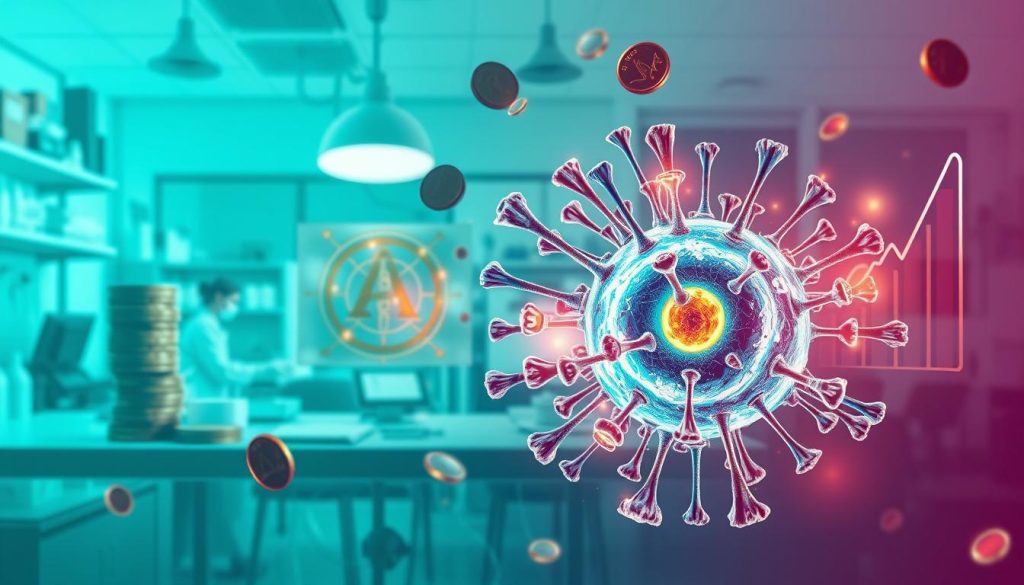
The cost of CAR T-cell therapy is complex. It includes hospital stays, the treatment itself, and follow-up care. It also includes indirect costs like lost wages and travel. Knowing these financial considerations helps patients prepare financially.
| Expense Category | Typical Cost Range | Comments |
|---|---|---|
| Initial Consultation and Testing | $3,000 – $5,000 | Essential diagnostic steps to determine therapy suitability |
| CAR T-Cell Processing | $300,000 – $500,000 | Costs for genetic modification of T-cells |
| Hospital Stay | $50,000 – $100,000 | Includes care pre and post-infusion |
| Post-Treatment Medications | $10,000 – $30,000 | Necessary for managing side effects |
| Follow-Up Care | $2,000 – $10,000 | Regular monitoring of patient’s response to treatment |
Insurance coverage for CAR T-cell therapy varies. Most plans cover it under certain conditions. But, patients may still face high costs. It’s important to talk about these cancer treatment costs with insurance and healthcare providers.
There are ways to help with the high costs of CAR T-cell therapy. Hospitals offer financial counseling, and non-profit groups help with treatment expenses. These resources can offer a lot of relief and support during treatment.
While financial considerations are tough for those thinking about CAR T-cell therapy, planning and using available resources can help. This way, patients can focus more on getting better and less on money worries.
Personalized Medicine: A New Era in Cancer Treatment
In the world of cancer care, personalized medicine is more than just a trend. It’s a big change towards care that fits each person better. Doctors can now create treatments that match a patient’s genes and needs perfectly.
Individualized Approaches to Cancer Care
At the heart of personalized medicine is the move away from one-size-fits-all treatments. It’s about making care that fits the unique details of each tumor. This change boosts treatment success and cuts down on side effects, making therapy better and easier to handle.
How Personalization Improves Success Rates
Personalized medicine focuses on each patient’s genetic makeup, leading to better treatment results, especially in complex diseases like cancer. Studies show that treatments based on a patient’s genes can lead to better outcomes and longer health compared to traditional methods.
| Treatment Type | Customization Level | Success Rate |
|---|---|---|
| Standard Chemotherapy | Low | Variable |
| Targeted Therapy | Moderate | Higher |
| Personalized CAR T-Cell Therapy | High | Highest |
This change in treatment approaches marks a hopeful new chapter in healthcare. Personalized medicine doesn’t just aim to cure but also to prevent and manage diseases better. The future of cancer treatment looks bright, driven by advances in tailored treatment plans.
Lymphocyte Engineering: The Technical Backbone
The world of cancer treatment is changing fast, thanks to lymphocyte engineering. It’s a key part of cellular immunotherapy, helping the body fight cancer better. This field keeps finding new ways to improve treatments, making them more effective and safer for patients.
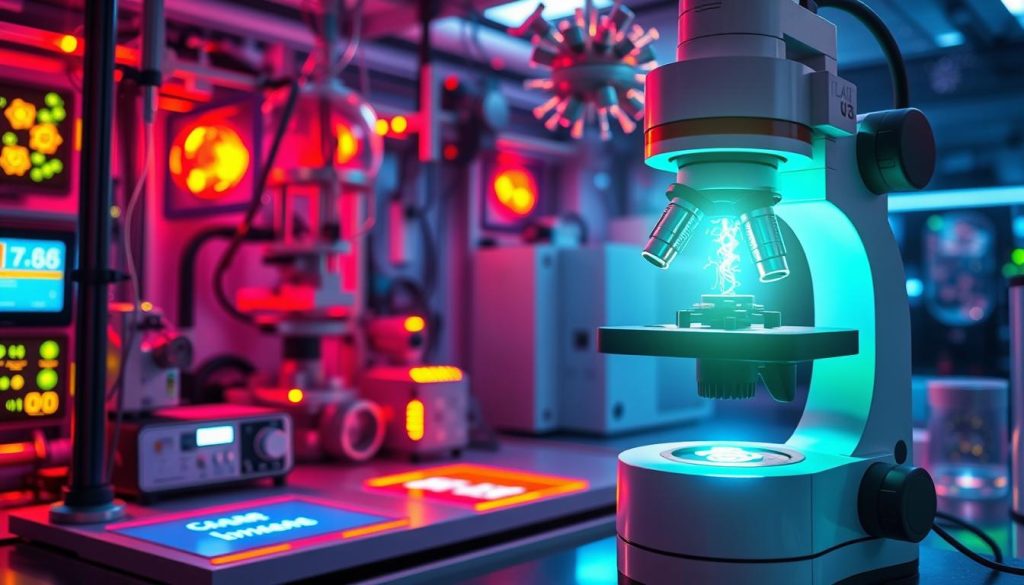
Advances in Cellular Immunotherapy
In recent years, advances in immunotherapy have been huge. They’ve marked a big step forward in fighting cancer. Cellular immunotherapy is especially promising because it can be tailored to each patient. This means it can target cancer cells better while protecting healthy ones, reducing side effects.
Cutting-Edge Techniques in Lymphocyte Engineering
The field of cellular immunotherapy has seen a lot of new techniques. Tools like CRISPR let us make precise changes to immune cells. This helps them attack cancer cells more effectively. Also, biotechnology helps grow these cells outside the body before putting them back in. This ensures they work well in fighting cancer.
| Technique | Description | Impact on Cancer Treatment |
|---|---|---|
| CRISPR-Cas9 Genome Editing | Precisely alters DNA sequences in immune cells to enhance cancer targeting abilities. | Increases specificity of immune response, decreases collateral damage to healthy tissue. |
| Ex Vivo Cell Expansion | Grows large quantities of modified immune cells outside the patient’s body. | Ensures a higher concentration of effective immune cells are reintroduced to fight cancer more robustly. |
| Checkpoint Inhibitors | Drugs that help immune cells recognize and kill cancer cells. | Boosts immune system functionality, overcoming evasion tactics by cancer cells. |
Ongoing Research and Future Directions
The field of CAR T-cell therapy is growing fast, thanks to ongoing research and clinical trials. This area is not just improving cancer treatments. It’s also showing promise for fighting other serious diseases.
Current Clinical Trials and Innovations
New studies in CAR T-cell therapy are showing great progress. They’re working on making the treatment safer and more effective. These efforts are crucial for better results in more people.
Researchers are looking to reduce side effects and improve how well the treatment targets cancer cells. This work aims to make the treatment more effective and improve patients’ lives after treatment.
The Potential of CAR T-Cell Therapy in Other Diseases
Scientists are excited about using CAR T-cell therapy for more than just cancer. They think it could help with autoimmune diseases and some viral infections too. This opens up new possibilities for treating different health issues.
Seeing CAR T-cells as a solution for many diseases is a big step forward. It could lead to a more comprehensive approach in medicine. This could change how we care for patients in many ways.
As we explore these new paths, supporting innovative clinical trials and research is key. The goal is to bring these discoveries to patients everywhere. This could bring hope and healing to many people around the world.
Challenges in Adoptive Cell Transfer
Adoptive cell transfer therapy, especially in cancer treatment, faces many challenges. CAR-T cell therapy has the power to change cancer treatment. But, it’s held back by big adoptive cell transfer challenges. The key issue is the complex cellular product manufacture process.
This process involves making and growing immune cells to fight cancer. It’s a detailed and tricky task.
The Complexities of Cellular Product Manufacture
Creating CAR-T and other CAR immune cell therapies is very precise. It needs to be both effective and safe. The process of changing cells to carry CARs and growing them is very demanding.
It also requires a lot of skill and resources. Traditional CAR-T cell therapies are made for each patient. This makes things more complicated and expensive.
Navigating Regulatory Hurdles
Another big problem is regulatory hurdles. These treatments are new and powerful, so rules are strict. Every step, from research to trials, must meet high standards.
People working in this field are not just scientists. They’re also helping shape the rules. The article talks about immune cell engineering strategies. It shows how important it is for scientists, regulators, and others to work together. This helps get treatments to patients faster, while keeping them safe.
FAQ
Q: What exactly is CAR T-Cell Therapy?
A: CAR T-cell therapy uses modified T-cells to fight cancer. T-cells from patients are changed to find and kill cancer cells. This way, the body’s immune system gets a boost to fight cancer.
Q: How is CAR T-Cell Treatment different from traditional cancer therapies?
A: CAR T-cell therapy targets only cancer cells, unlike traditional treatments. This makes it more precise and can reduce side effects. It uses the body’s immune system to fight cancer.
Q: Who is eligible for CAR T-Cell Treatment?
A: Who can get CAR T-cell treatment depends on their cancer type, stage, and health. Doctors carefully check if the treatment is right for each patient. This ensures it’s safe and effective.
Q: What does the CAR T-Cell Treatment procedure involve?
A: First, T-cells are taken from the patient. Then, they are changed in the lab to fight cancer. These modified T-cells are given back to the patient to attack cancer cells.
Q: What are the financial considerations associated with CAR T-Cell Therapy?
A: CAR T-cell therapy is expensive. Costs can vary, and insurance may cover some or all of it. It’s important to talk about costs with doctors and insurance.
Q: Can CAR T-Cell Therapy be considered a form of personalized medicine?
A: Yes, CAR T-cell therapy is a perfect example of personalized medicine. It’s tailored for each patient, making it more effective in fighting cancer.
Q: What are the potential side effects of CAR T-Cell Treatment?
A: Side effects can range from mild to serious. These include flu-like symptoms and conditions like cytokine release syndrome. Close monitoring is key to manage these side effects.
Q: What is the role of lymphocyte engineering in CAR T-Cell Therapy?
A: Lymphocyte engineering is crucial in CAR T-cell therapy. It involves modifying T-cells to target and destroy cancer cells. This makes the treatment more effective.
Q: What does the future hold for CAR T-Cell Therapy?
A: The future of CAR T-cell therapy looks promising. Ongoing research and trials are exploring new uses and improvements. It could lead to better treatments for various diseases.
Q: What challenges are faced in the field of adoptive cell transfer?
A: Challenges include making the treatment process consistent and navigating regulations. Efforts are being made to make it more accessible and effective.













